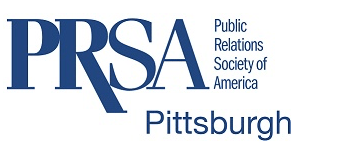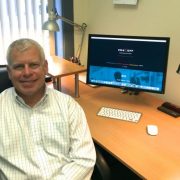[ Practitioner Profile: Each month, we will feature public relations and communications practitioners from the Pittsburgh area as a way to highlight their experience and share their insights and learnings gleaned during their professional careers. We also will feature local executives who may not be public relations practitioners themselves, but who believe in the power of public relations. If you’d like to hear from someone specific, please email us at allison.peiritsch@sru.edu. ]

1.Tell us about your academic background.
I graduated magna cum laude from the S.I. Newhouse School of Public Communications at Syracuse University with a Bachelor of Science in Broadcast Journalism. I minored in political science.
2. What was your first job and how did you find it?
My first job was as a part-time radio news anchor/reporter for a commercial radio station in Syracuse during my senior year in college. A friend was employed there, and the station was seeking additional newsroom staff. I had already been anchoring news on the college radio station at Syracuse University, so I had a radio news resume/demo tape and was able to secure employment as the Saturday night news anchor. Later, I became a part-time reporter and news writer for the station. The radio news resume tape I developed while working there helped me to secure my first full-time job as a radio news reporter before I graduated from college.
3. What was the most important lesson you learned from that job that you still carry with you?
Always look for options rather than obstacles. I was a very young reporter in my college town, and I carried plenty of responsibility. I was on deadline constantly, and I had to often find new ways of attacking a challenge to make sure I got the story and got it right. It was a phenomenal learning experience.
4. Give us a snapshot of the remainder of your career path, in addition to your current job and responsibilities.
After graduating from college, I began a ten-year career as a broadcast journalist, primarily in Harrisburg, PA. I began working as an anchor/reporter at an all-news radio news in Harrisburg and then transitioned into TV news several years later – first as an assignments manager, then as a reporter for the Fox and NBC affiliates in Harrisburg. Eight years after graduating from college, I was hired as the main anchor for the Fox affiliate in Youngstown, OH, which enabled me to return to Pittsburgh. I spent two years there. During a decade as a broadcast news professional, I was honored to win six Associated Press awards for outstanding news reporting.
My first job in my second career as a public relations/marketing practitioner was as the director of marketing and public relations for La Roche College in Pittsburgh. I spent five years there, and our team successfully implemented a comprehensive enrollment marketing strategy that netted the largest class of students in the institution’s history at the time. We also won a host of awards for the college’s website, recruitment materials, a TV commercial and the alumni magazine.
I then began a long and fulfilling eight-year run at Elias/Savion Advertising and Public Relations in Pittsburgh. I was hired as PR manager, promoted to director of public relations, and ultimately was made vice president of communications during my tenure. I served as chief communications counselor to all of the agency’s clients and oversaw the public relations and communications practices at the agency. The list of clients included everything from a national wireless communications provider to a national retail development client, a national window and door manufacturer, a regional financial institution and a regional law firm. Our team won a number of PRSA awards, and I was instrumental in building the agency’s crisis communications and media training disciplines.
My next stop was at Burson-Marsteller in Pittsburgh, where I served as senior counselor to a leading financial services/insurance company for about a year and a half. Our team successfully developed and launched a multifaceted public relations program that included the appointment of an NFL Hall of Famer as the brand ambassador and the creation and deployment of a nationwide survey on retirement and financial planning.
I then joined Michael Baker International, a global engineering firm in Pittsburgh, as director of corporate affairs for business operations, where I oversaw communications for the company’s six regions along with its markets and practices. During my one-year tenure at Michael Baker, our team generated enhanced visibility and greater share of voice for the company through a comprehensive, re-engineered media relations and thought leadership program. We also increased engagement levels for the company with clients, prospects and employees by creating and launching a stakeholder communications program across several owned channels.
In May 2016, I returned to Elias/Savion Advertising and Public Relations as executive vice president and director of account management. I was fortunate to rejoin my former employer in an elevated role as a member of the agency’s senior leadership team. My charge in my new role is to serve as the lead contact for the agency on several of its key accounts while working to strengthen current client relationships and assist the team in generating new business.
5. What was the best piece of advice that you ever received?
Lead by example. Always demonstrate that you are prepared to go the extra mile, to roll up your sleeves and get your hands dirty regardless of your title. Never ask anyone else to do what you are not willing to do yourself.
6. Tell us about a memorable moment in your career.
Near the end of my career as a TV news reporter, my photographer and I covered an apartment fire in suburban Harrisburg that ultimately transformed into multiple deliberately set fires across the city in the span of four hours. Flames chased families in several locations into the streets. We had to chronicle the developments well into the overnight hours, following firefighters and interviewing frightened neighbors and residents who weren’t sure where the arsonist was going to strike next. It was a harrowing experience and a reminder of how one person’s actions can cause chaos and despair for many people in a short period of time.
7. In your opinion, what are the three most important attributes needed to be a successful public relations practitioner?
- A strong writer: Someone who truly wants to be successful in public relations needs to be adept at writing well and writing on deadline. Public relations practitioners need to be able to digest and translate sometimes difficult concepts into something discernible and meaningful.
- A story teller: Public relations is about telling good stories – about people, about organizations, about companies, about ideas. Do you know how to recognize the elements of a good story, to cultivate them, to piece them together into a cohesive and impactful narrative? Can you telegraph their significance to all the audiences that matter? And, do you know how to craft that narrative for all the channels – paid, owned, earned and shared – that people follow today?
- Fearlessness: From my experience, success in this business requires an element of fearlessness. You never know what might be around the corner – from managing demanding clients to interacting with the media, creating compelling content on deadline and constantly keeping up to date on what is happening in the world. Approach each day with confidence and a willingness to put in your all, and you’ll do well.
8. What is your advice to students who want to work in public relations or young public relations professionals just starting their careers?
I’m a news junkie, and it has always served me well. My advice: Read and absorb every bit of news and information you can from multiple sources. Understand what is happening in the world – in business, in politics, in entertainment, in general. A well-informed public relations professional is a powerful consultative agent for his/her client or and/or employer.
9. How has the public relations field changed since you started working?
Social media has completely transformed the paradigm. In many ways, it has put technology into the hands of “citizen journalists” who do not follow the same rules of engagement as traditional journalists. At the same time, it has leveled the playing field for brands to interact directly with their constituencies. It is an entirely different world, one that is constantly evolving.
10. What’s next? What do you see as the next big trend in public relations?
Based on my background in agency, nonprofit and corporate PR/marketing, the development and dissemination of compelling content has never been more of a priority for organizations of all sizes. It’s about telling good stories on multiple platforms to create an impactful narrative for the brand.







